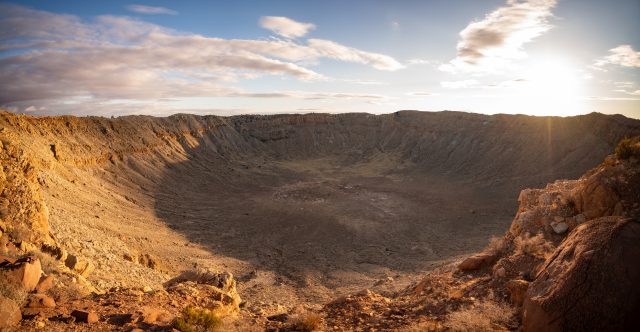This website uses cookies so that we can provide you with the best user experience possible. Cookie information is stored in your browser and performs functions such as recognising you when you return to our website and helping our team to understand which sections of the website you find most interesting and useful.
‘Nano-diamonds’ in soil found to enhance Languedoc wine
A series of geological studies have shown that wines made by Domaine du Météore take their minerality from nano-diamonds created by the impact of a meteor strike more than 10,000 years ago.

There has been much debate over the years as to whether a 200 metre-wide sinkhole found on land owned by Languedoc wine producer Domaine du Météore is in fact the impact site of a meteor strike.
The claim was first made in 1950 by two French scientists who believed that the crater, and four other smaller craters in the village of Cabrerolles, were caused by a meteorite impact. Their theory was corroborated by a Scandinavian astronomer a year later who identified “magnetic anomalies” at the location, which he said could only have been caused by a direct meteor hit.
A fourth scientist publicly contested the notion in the 1960s, and though no scientific evidence was submitted to disprove the meteor theory, it nevertheless threw a question mark over the idea. When the winery opened for business in the 1980s and chose to name itself Domaine du Météore, there was little hard evidence at the time to show that its vineyards were nestled inside a meteoric crater.
Now, however, a team of experts from Goethe University Frankfurt has just been able to prove the impact origin.
Following detailed mineralogical and geophysical field work, Professor Frank Brenker from the Department of Geoscience at Frankfurt University and Professor John Cosgrove, Professor of Structural Geology at Imperial College, claim they have been able to prove beyond doubt that the hole in the ground on Domaine du Météore’s property was caused by a meteorite strike. Not only this, but that the vines grown in its soil are enhanced by the meteorite’s impact.
In addition to confirming the significant change in magnetic field within the crater and the presence of typical deformation of rocks within crater samples, Brenker also found tiny spherules of iron-nickel widely scattered in the vine plots around the crater.
Electron microscopy has shown that these spherules contain fragments of the impact rocks as well as ‘microdiamonds’, formed by the immense force (equivalent to that caused by a nuclear explosion) experienced at the time of impact on carbon within the rocks.
According to Professor Cosgrove, it is these nano-diamonds that “give the wine its sparkle.”
“We have always known that our vines grow in and around a meteorite crater based on early scientific studies from 1950,” said Paul Jenkins, owner of Domaine du Météor.
“It was fantastic to have this confirmed by expert geologists who visited us recently and who are as excited as we are to have discovered the physical signs of the meteor impact over 10,000 years ago.”
The domaine is situated in the foothills of the Haut-Languedoc mountains, and its terroir is formed of rocky blue and yellow schist, surrounded by wild thyme, fennel and mint. Farmed organically for almost 15 years, the domaine is now in biodynamic conversion.

